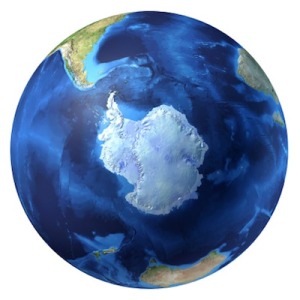The North Pole is at the top of the world.
The South Pole is at the bottom of the world.
Both are very cold, icy places.
The Poles have six months of daylight and six months of night.
The Earth spins on an axis. Point to the North Pole and to the South Pole! Point to Australia: we are closer to the South Pole than the North Pole. ©Getty
The North and South Poles are at the top and bottom of the world.
Imagine a stick poking right through the Earth - this is called the axis. Now imagine the axis is tilted slightly. The part of the imaginary stick that pokes out at the north, or top, is the North Pole, and the one at the other end is the South Pole. The Earth spins on this axis, which gives us day and night.
Imaginary lines radiate out between the Poles: these are lines of longitude. The lines that go around the globe the other way are lines of latitude - the Poles are located at 90º north and 90º south.
Lines of longitude radiate from each Pole. ©Getty Images
The North Pole
There are three North Poles: a geographic North Pole and a magnetic North Pole. There is also a geomagnetic North Pole, which is a very difficult scientific concept to understand.
The geographic North Pole is located about 725 km north of Greenland in the middle of the Arctic Ocean. This is called true north. Most of the time, the North Pole is covered in sea ice. The North Pole has six months of daylight and six months of darkness.
© Getty Images
The magnetic pole is due to magnetic fields that are generated deep in the core of the Earth. These fields change slowly and flip from south to north on a very long time scale. The magnetic North Pole is about a 160 km south of the geographic North Pole, although this is not fixed and changes each day. When you look at a compass, it points to this point, so navigators must be aware of the difference between magnetic north and true north.
It is generally thought that the first people to reach the North Pole were Robert Peary and Matthew Henson, with four Inuit guides, on 9 April 1909, although it is suspected that they may have missed the actual spot by a few miles. Roald Amundsen was the first person to see both Poles.
Antarctica © Getty Images
The South Pole
There are actually four South Poles! A geographic South Pole, a magnetic one, a geomagnetic one, and a ceremonial one.
The geographic South Pole marker is moved each year because the glacier on which it is located moves each year. ©Getty
The Geographic South Pole is the bottom part of the Earth's axis. It is the place from which the longitude lines on the map radiate out.
Because the South Pole is on a glacier that moves about 10 metres a year, the marker has to be relocated each year, using satellite positioning systems. So even though the South Pole itself doesn't really move, the ice moves, along with markers stuck in the ice, so the correct place has to be marked each year.
The first expedition to reach the South Pole was led by Roald Amundsen, on 14 December 1911. A second expedition led by Robert Falcon Scott reached the Pole just five weeks later, on 18 January 1912. A sign that records the dates on which Amundsen and Scott each reached the Pole, and a quote by each, is also relocated each year.
This sign is also relocated each year. ©Getty
© Getty images
There is a ceremonial South Pole which is now actually a few hundred metres away. It is a decorated copper pole surrounded by the flags of the twelve original nations that signed the Antarctic Treaty and have territory in Antarctica. Because it is more elaborate, and would involve moving the flags also, this one is not moved each year. But it is the one that is photographed!
The South Magnetic Pole is in the Antarctic Ocean and not even located on Antarctica! It is the southern pole of the Earth's magnetic field, and its technical name is the south magnetic dip pole. It is at the point on the Earth where a compass needle, which is able to move vertically as well as horizontally, points straight up. The magnetic pole is due to magnetic fields that are generated deep in the core of the Earth. These fields change slowly and flip from south to north on a very long time scale. For that reason, the south magnetic pole is rarely found precisely at the real South Pole of the Earth. It varies by several kms a year and was last located precisely in 1986 when it was at 65.3º south (latitude) and 140 º east (longitude).
It’s a good idea to get information from more than one source!
Read kidcyber pages about Antarctica
The Race to the South Pole (who got there first?)
Read more about the South Pole
https://kids.kiddle.co/South_Pole
Read more about the North Pole
https://kids.kiddle.co/North_Pole
Watch a video about the North and South Poles
https://www.youtube.com/watch?v=13blTsIDMOQ









